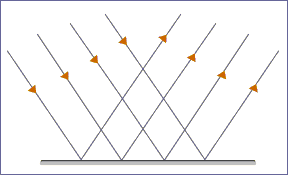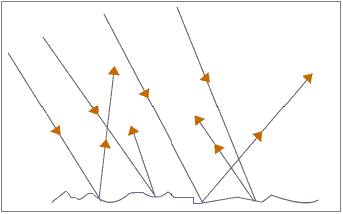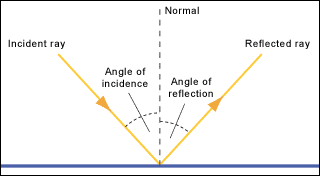Sources of Light
Propagation and Transmission of Light
Reflection of Light
The Concept of Reflection of Light
Explain the concept of reflection of light
Reflections are obtained from hard and highly polished surfaces such as mirrors and sheets of glass than from rougher surfaces, when light falls on the surface at an inclined plane angle, it is sent back into the air. This is also the case when light falls on all highly polished metals. If light falls on a polished surface at an angle 900, it is sent back into the air on the same path.
Difference between Regular and Irregular Reflection of Light
Distinguish regular from irregular reflection of light
Surface can be classified into two types:
- Highly polished surfaces, examples are mirror, polished cooking utensil and silvered iron sheets.
- Rough surface, examples are unpolished wooden table, sheet of paper and cobblestone road.
Application of the Laws of Reflection of Light
Apply the laws of reflection of light
Reflection is guided by some natural laws called “Laws of reflection” the Laws of reflection state that:
- The incident ray, the reflected ray, and the normal at the point of incidence all lies in the same plane.
- The angle of incidence is equal to the angle of reflection.
Image Formed by a Plane Mirror
Describe image formed by a plane mirror
A clear image is recognised as a result of reflection of the beam striking the highly polished surfaces. This is called regular reflection.

Regular reflection.
If mirrors were replaced by a piece of sheet of paper, there would be no image to be seen even as a result of diffuse or irregular reflection, this is shown below.

Irregular or diffuse reflection.
Terms used in reflection
When light rays strike a surface (e.g a mirror) there are two rays of importance, namely Incident and Reflected rays, see the figure below:

Reflection of light rays.
- MO is a ray of light falling on a mirror; it is called the incident ray.
- OP is a ray of light leaving the mirror after reflection; it is called the reflected ray. Line NO is perpendicular to the mirror , it is called the normal. ANGLE MON is called the angle of incidence. (i) this is the angle between the incident ray and the normal , angle NOP is called the angle of reflection (t). this is the angle between reflected ray and the normal.






